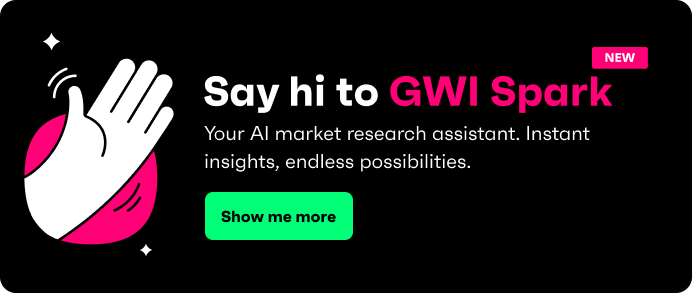Social media is more than just another tool in your marketing arsenal - it’s the place for consumers to connect, discover, and shop. With more than a quarter of the average person’s online time spent on social platforms, it’s clear we’re not logging off anytime soon.
In 2025, engagement is the new currency. It’s not about how many followers you have - it’s about how they interact with you. Watch time, post saves, and video completion rates are the metrics that matter. Social search is booming, with younger generations using TikTok and Instagram like Google, and private spaces (DMs, group chats, and brand communities) are becoming the new hubs for meaningful connections. Meanwhile, AI is shaking up content creation, customer service, and analytics.
So, how do you keep up? This guide breaks down everything you need to know - why social media matters, how to build a winning social strategy, and what trends are shaping the future. Let’s dive in.
Why social media marketing matters in 2025
Gone are the days of exclusively mindless scrolling. Today’s consumers are using social media to research, engage, and buy. Platforms like TikTok, Instagram, YouTube, and Threads aren’t just shaping culture - they’re shaping purchasing decisions.
And let’s be real - social media isn’t going anywhere. Despite the “I’m going to scroll less” resolutions, only 25% of people actually reduced their screen time in 2024. The rest are still glued to their feeds.
So, what’s changing? Algorithms are king. If your content doesn’t hook people fast, it’s dead on arrival. Watch time and post saves now matter more than vanity metrics like followers and likes. Social media is also becoming the new search engine. Forget Google - Gen Z is heading straight to TikTok and Reddit for recommendations, reviews, and discovery.
Meanwhile, private spaces are taking over. DMs, group chats, and customer communities have become the real hubs of engagement, shifting brand-consumer interactions away from public feeds and into more personal, direct conversations. Brands can no longer rely solely on public-facing posts - they need to show up where their audiences actually are.
Bottom line? You can’t treat social media like it’s still 2019. Social media is evolving - smart brands evolve with it.
The business benefits of social media marketing
Social media isn’t just a brand awareness tool - it has the potential to be a full-funnel marketing powerhouse. From engagement to conversions, here’s what you stand to gain.
Brand awareness and visibility
Forget chasing followers. In 2025, winning brands focus on creating content that people actually engage with. It’s not about how many people see your content - it’s about how many stop, watch, and interact.
Short-form video still dominates, but long-form is making a comeback. Platforms like TikTok, Instagram, and YouTube are all extending video lengths, giving brands more space to tell compelling stories. At the same time, TikTok and Instagram are becoming search engines in their own right, particularly for Gen Z, making social search optimization just as crucial as traditional SEO.
And let’s not forget YouTube Shorts. Over half of YouTubers used Shorts in the last month, proving that bite-sized, algorithm-friendly content still holds massive influence. Brands that master the balance between short, attention-grabbing clips and deeper, long-form storytelling will lead the way.
Consumer engagement and community building
Social engagement isn’t just happening in public anymore - it’s moving into DMs, group chats, and customer communities. Consumers expect brands to do more than post; they want real conversations. Messaging apps and private groups are booming, with brands like Tommy Hilfiger integrating WhatsApp into their customer service strategies.
Even in public spaces, engagement matters, and brands that actively interact in the comments build deeper connections. Duolingo, for example, has turned witty, engaging replies into a signature marketing strategy, proving that even a language-learning app can spark viral conversations.
At the same time, consumers are increasingly mindful of the role social platforms play in shaping online discourse. 6 in 10 consumers say free speech on social media is very or extremely important, and while engagement thrives on this openness, audiences also expect platforms to balance free expression with responsible content moderation. Brands that navigate this landscape thoughtfully will build the most loyal and engaged communities.
Lead generation and conversions
Social commerce is changing the way people shop, making it easier than ever to discover and buy products without ever leaving the app. And no platform is leading this shift quite like TikTok. Shopping on TikTok isn’t just about clicking “add to cart” - it’s an experience. With TikTok live shopping, brands and creators can showcase products in real time, answer questions on the spot, and turn casual viewers into instant buyers. It’s interactive, fast-paced, and designed for impulse shopping. And it’s working - nearly two in five US users have watched a TikTok livestream in the past month.
At the same time, influencer marketing is evolving beyond one-off promotions - creators are seeking deeper, long-term brand partnerships that feel more authentic to their audience. And authenticity matters: Consumers who watch vlogs for product research are the most likely to trust online reviews, showing that video-based content continues to be a powerful driver of conversions. For brands, the takeaway is this: invest in video, build genuine influencer relationships, and make the buying process as seamless as possible.
Data-driven marketing and insights
Social media platforms don’t just drive engagement, they’re a goldmine of real-time insights that help brands refine targeting and optimize campaigns. Every like, comment, share, and search tells brands something valuable about their audience. By delving into these analytics, companies can track emerging trends, understand shifting behaviors, and refine their targeting faster than ever. Instead of guessing what consumers want, brands can use data to deliver exactly what resonates.
To get a leg up on monitoring these trends, brands are turning to social listening tools and platform analytics to track conversations, sentiment, and engagement patterns across different demographics. A prime example of how quickly consumer behavior can shift is the rise of Threads - now the fastest-growing platform across generations. The impact is especially clear in Taiwan, where one in five consumers logs into Threads daily, making it the country's third most-used app.
This kind of data isn’t just useful - it’s essential. Brands that stay agile, analyze platform trends, and adjust their strategies in real time will be the ones that stay ahead.
Social media marketing strategy: A step-by-step approach
A winning social media strategy isn’t built on guesswork - it’s a structured process. Follow these steps to ensure your approach is clear, data-driven, and optimized for success.
Step 1: Define your goals
Success starts with clear objectives. Instead of chasing vanity metrics, brands need to focus on the right KPIs. If your goal is brand awareness, track watch time, video completion rates, and saves. For relationship-building, prioritize comments, DMs, and community engagement. And if conversions and sales are the target, clicks, conversions, and in-app purchases should be your key metrics.
By focusing on the right KPIs, your social media efforts will deliver real business impact - not just vanity engagement.
Step 2: Understand your audience
You can’t win on social media if you don’t know who you’re talking to - or why they’re there in the first place. That’s why smart brands take the time to understand what drives their audience, using tools like GWI’s audience data to segment users by intent, interests, and behaviors. The more you know, the easier it is to create content that actually resonates.
Platform trends also matter: Millennials are embracing Threads, while Gen Z dominates TikTok and Snapchat. And engagement habits play a role too - people who actively participate in discussion-based social media are more likely to view these platforms as beneficial, reinforcing the need for brands to foster real conversations within their communities.
Step 3: Choose the right platforms
When it comes to social media, being everywhere isn’t really a strategy. The smartest brands focus on the platforms where their audience is most engaged and where their content will have the biggest impact. Each platform has its own strengths, and understanding how people use them is key to making the right investments.
Instagram and TikTok lead the way in video-first content, social commerce, and influencer marketing. If your brand thrives on short-form video, product discovery, and community-driven trends, these platforms are non-negotiable. Meanwhile, YouTube remains an underutilized option for brands, despite its dominance in long-form video and search-driven content - marketers who overlook it are missing a huge opportunity.
Newer platforms are also shifting the landscape. Threads is quickly emerging as a go-to space for real-time discussions and news, while Snapchat, often thought of as Gen Z territory, is quietly gaining traction among older demographics. The takeaway? The right platform strategy isn’t about spreading yourself thin - it’s about showing up where your audience actually spends their time and engaging with them in ways that feel natural to each platform.
Step 4: Content creation and distribution
The best-performing content formats are evolving, and brands need to adapt. Longer videos are gaining traction on TikTok and YouTube, with 10-minute-plus content seeing increased engagement. Livestream shopping is booming, particularly in Western markets, offering real-time interaction between brands and consumers.
And while AI-generated content is becoming more prevalent, transparency remains key - users want to know when they’re engaging with AI-driven media. The brands that embrace these trends while still staying authentic will drive the most engagement.
Step 5: Paid vs. organic social strategy
Relying on organic reach alone isn’t what it used to be. With engagement shifting into private spaces like group chats and online communities, brands can’t just post and hope for the best - they need a mix of organic and paid strategies to stay visible and relevant.
The key is to be strategic with paid promotions. Instead of chasing vanity metrics like reach, brands should focus on meaningful interactions - think engagement, clicks, and conversions over passive impressions. Retargeting and influencer partnerships are likely to outperform broad catch-all ads because they feel more authentic and drive real action.
At the end of the day, the best approach isn’t all organic or all paid - it’s a smart balance. Organic content builds trust and community, while paid ads help amplify reach and keep audiences engaged beyond the feed. The brands that get this mix right will cut through the noise and create lasting connections with their audience.
Step 6: Measure and optimize performance
Tracking the right KPIs is what separates effective social strategies from wasted budgets. Watch time and completion rates reveal content effectiveness, post saves and shares indicate value-driven engagement, and community participation through comments and DMs measures real audience connection. The brands that consistently analyze and refine their approach based on these insights will outperform competitors still relying on outdated metrics.
The future of social media marketing
The brands that thrive in 2025 won’t just be keeping up - they’ll be leading the conversation. Winning brands will be audience-first, data-driven, and adaptable, evolving alongside shifting behaviors instead of playing catch-up.
AI, private communities, and search-driven social media are transforming how people engage online. The days of just broadcasting content and hoping for reach are over. The key? Engage, don’t just exist. Spark conversations, not just views. Build relationships, not just impressions.
Social media never stands still, so neither should your strategy. Brands that stay curious, experiment with new formats, and use real-time data to guide their approach will be the ones that build deeper connections and long-term success.






.webp?width=495&height=317&name=pink_thumb_graphs%20(1).webp)
.webp?width=495&height=317&name=pink_thumb_letter%20(2).webp)
